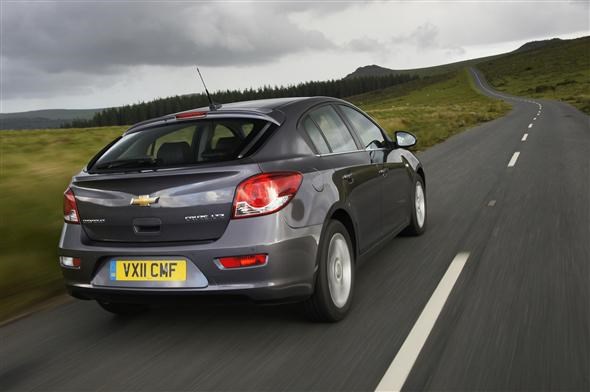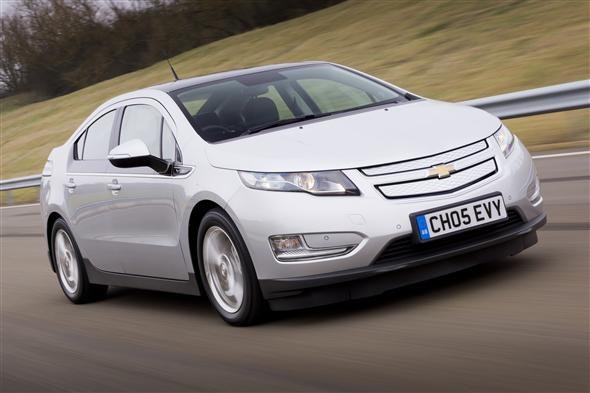Chrevolet has created a conundrum for the company car driver. On the list of choices there lies the Chevrolet Cruze – a 1.7-litre diesel, five-door hatchback – and then underneath that (if alphabetical order is in place) there’s the Chevrolet Volt, another five-door hatchback… but with a twist.
The Volt is a new type of car called a range-extender. Not strictly a hybrid, nor a full electric plug-in, but a vehicle where the wheels are driven by a 148bhp electric motor that draws its charge from a lithium-ion battery. You can charge the battery using the household mains and a full charge will take around six hours. For that you can run on battery power alone for about 25-50 miles depending on how hard you drive the Volt which, on its own, isn’t much cop.
That’s where an 86bhp 1.4-litre petrol-powered engine kicks in to give you a theoretical range of around 300 miles which, with the electric motor, is enough for most motorists.
The advantage that the Volt has over its conventionally powered rivals, including the diesel Cruze, is that it can be extremely economical. If you are travelling no more than 30-odd miles a day – normal for the majority of UK motorists – the car can potentially run on battery power alone and easily achieve the claimed fuel economy of 235mpg. This is unrealistic for most but even we achieved an average of about 75mpg on our test.
There are four driving modes: Normal, Sport, Mountain and Hold for a variety of driving situations but, most importantly, Hold enables the driver to preserve the full energy stored in the battery pack. That means you can run on electric power when you are leaving a city, press Hold, run on petrol power to get you to another city, then press Hold again to fully utilise the battery’s electric power in busy traffic.
Some US customers have claimed to have driven 1,000 miles before filling up the fuel tank. According to American talk show host Jay Leno, the Volt he bought last year came with a full tank of petrol and since then he has travelled 11,000 miles using less than half a tank of fuel – around four gallons – which means an average of around 2,365mpg.
Clearly then, the Volt has a number of money saving benefits for company car drivers particularly when you factor in the CO2 emissions rating of 27g/km.
The Volt’s P11d value, with sat nav, comes out at £34,995 but the low emissions mean a Benefit-in-Kind banding of 5% and a £58.32 monthly outlay for a 40% tax payer. That’s cheap when you consider a Golf BlueMotion will cost you in the region of £80 a month.
As a driving machine, the Volt is more than competent. It corners nicely, and although the 198kg battery means you need commitment on the brake pedal to get you to stop, there’s more than enough pull for you to get away quickly. The benchmark 0-60mph time takes 9.0 seconds and it’ll do a top speed of 99mph.
Inside it’s of a decent quality and the computer wizardry does pep up the interior. Rear visibility is compromised by the split rear window and the massive front pillar seriously restricts the view when turning out of tight angles. The boot isn’t particularly large and there are only four seats.
So what if you are thinking of going for a conventional diesel hatchback? Well, the Cruze might be on your radar and, with the new 1.7-litre diesel engine, you could be tempted by the cheap purchase price, a 72.4mpg claimed average fuel economy and the 117g/km CO2 emissions rating. If you go for the range-topping LTZ, priced at £18,685, you’ll pay around £104 a month in company car tax if you are a 40% tax payer – almost double the cost of the Volt.
To drive, the Cruze is acceptable, but nothing to get too excited about. The 128bhp 1.7-litre diesel engine offers decent acceleration – 0-60mph in 9.4 seconds – and a top speed of 124mph. Although the stats are superior to that on the Volt, it doesn’t feel as urgent or as much fun. The Cruze isn’t dynamic, but it is adequate for everyday driving. The car rides well, the seats are comfortable, but it still feels a little cheap inside.
In some respects it is unfair to compare the two. They do come from the same stable, but the hugely different powertrains are chalk and cheese. Still, if you are looking for a Chevvy that’s cheap to run, has some attitude about it and is nice to drive, then the Volt wins hands down.








